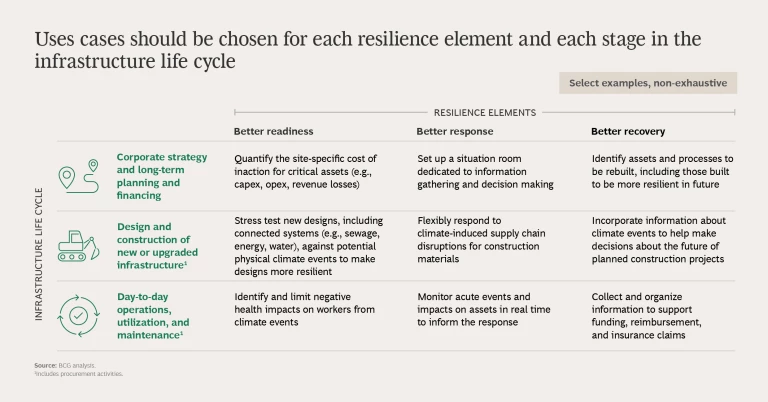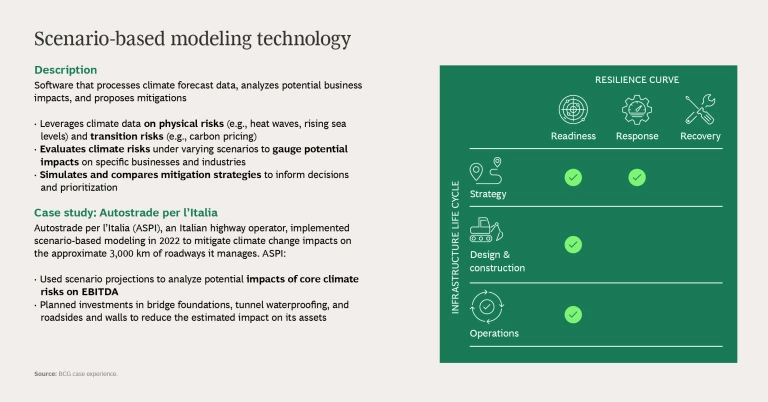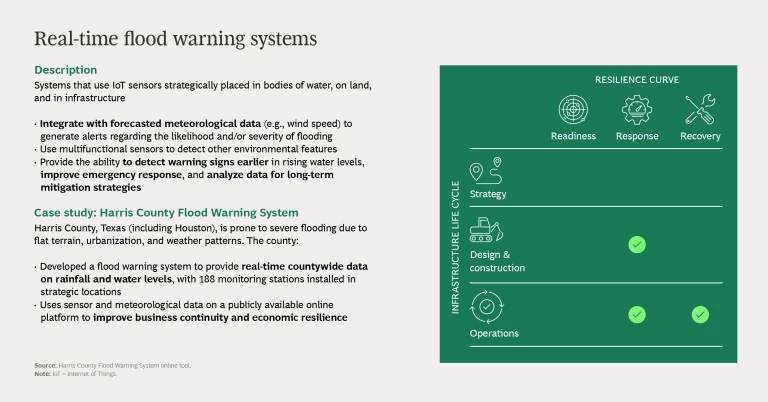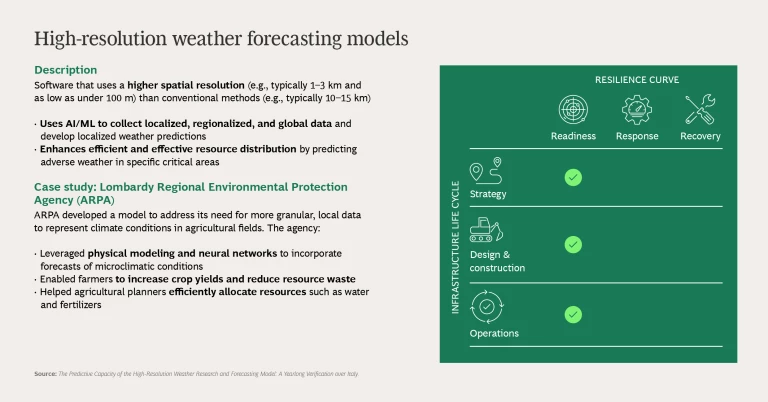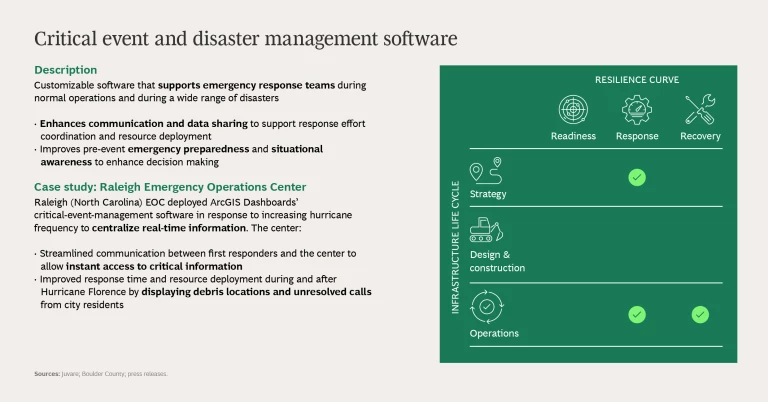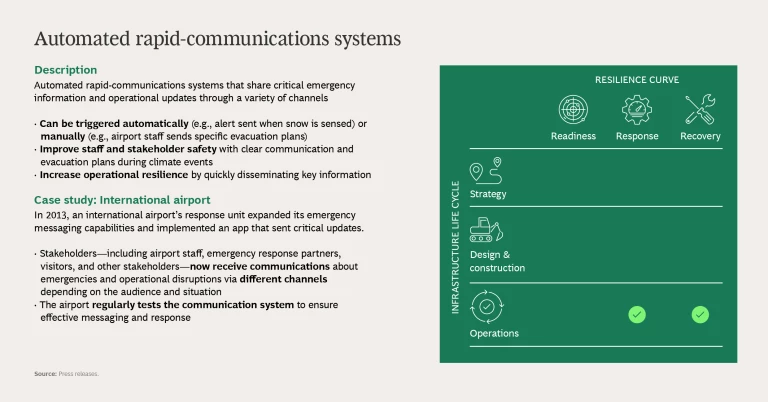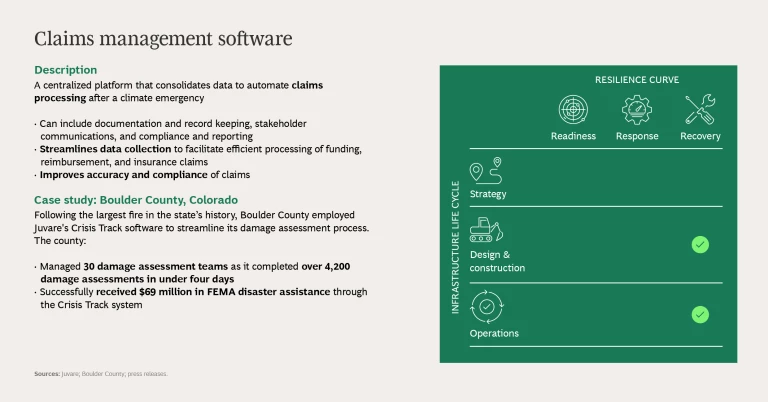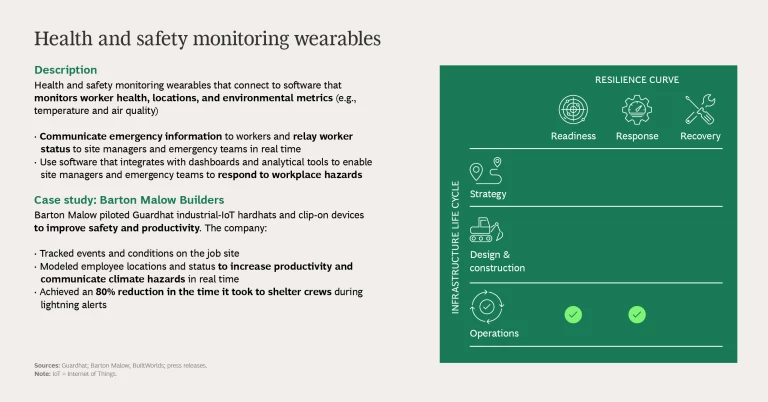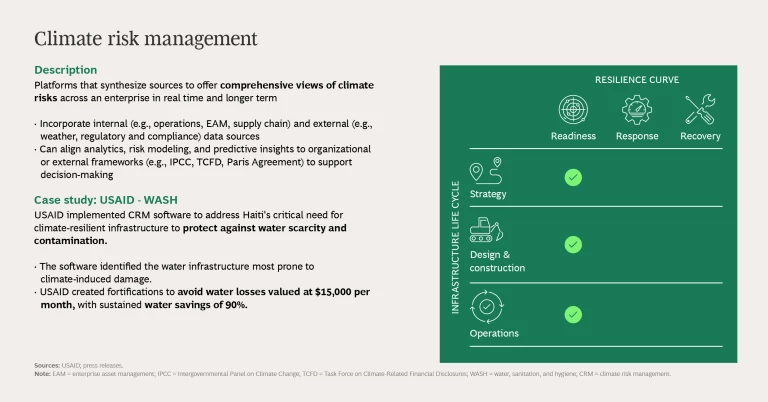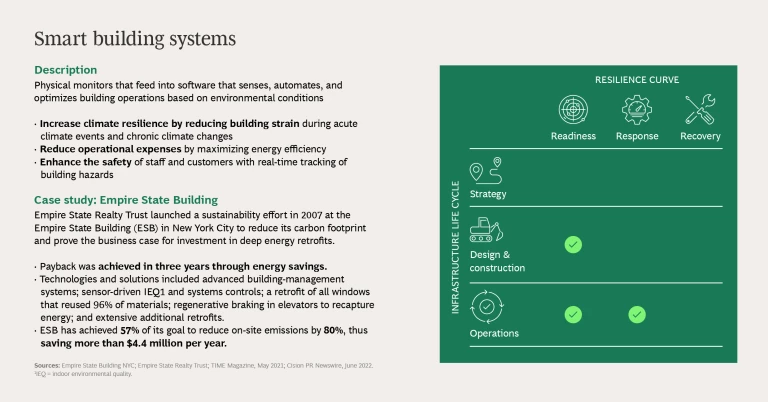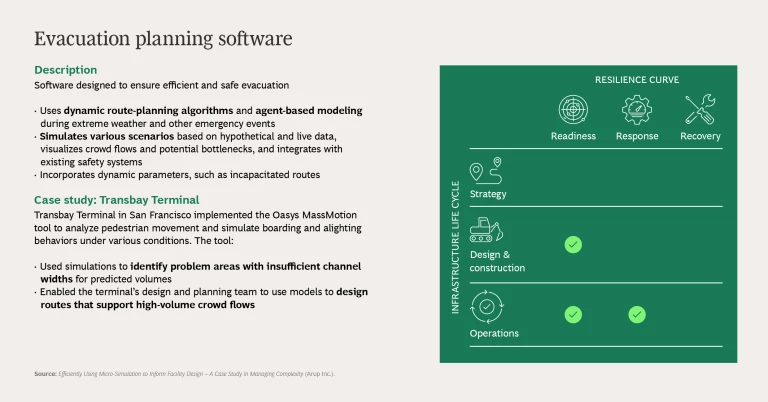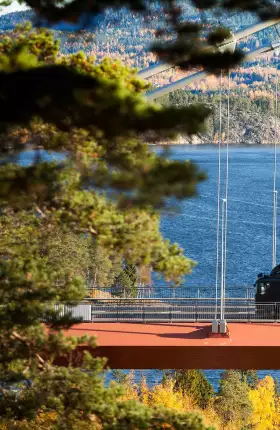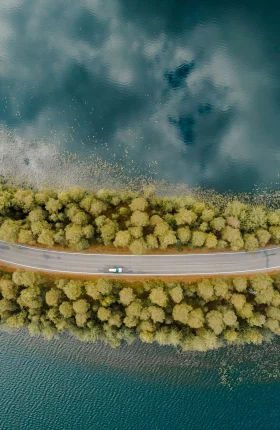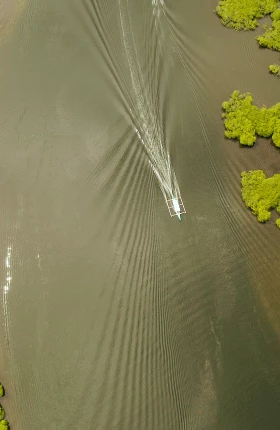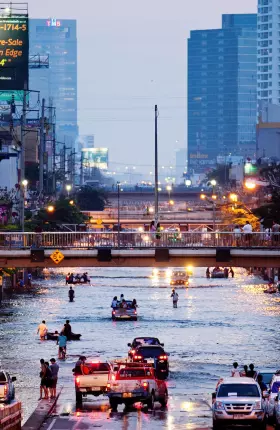Technology giants and small startups alike are developing innovative tech solutions that can anticipate and mitigate the escalating risks associated with climate change, helping to move the needle in climate resilience. For organizations that develop and maintain transportation infrastructure for road, rail, ports, and airports, the need for these solutions is immediate. Despite the commitments outlined in the Paris Agreement, the world is not making enough progress to limit global warming to below 1.5⁰C by the end of this century. And transportation infrastructure is inherently embedded in natural environments. As a result, rising temperatures, fires, droughts, flooding, and severe weather are already placing it under significant strain.
In response, transportation organizations are increasingly shifting from a pure focus on sustainability to one that encompasses climate resilience—the ability to ready themselves, respond, and recover from the effects of climate events in an efficient and timely manner. However, progress is still sluggish. For example, the U.S. Climate Resilience Toolkit reveals that proactive implementation of resilience measures is still limited across the US transportation sector, suggesting that many organizations do not have full-scale plans in place. And a global BCG analysis of more than 100 adaptation and resilience (A&R) projects in land transportation infrastructure reveals that much is still lacking in terms of comprehensive, coordinated solutions.
An optimal approach to A&R means proactively understanding an organization’s vulnerabilities and developing a holistic strategy for decreasing risk and enhancing resilience. This means taking into account not only physical measures, such as the building of sea walls or fire barriers, but also technology-based solutions. These should cover two dimensions: the complete “resilience curve”—from readiness and response to recovery—and the full infrastructure life cycle.
A Use-Case-Driven Approach to Technology Solutions
Choosing the right tech solutions can be a difficult task, given that the field is complex and continually evolving. As leading transportation agencies, operators, and developers search for the most relevant and effective options, a use-case-driven approach can help. It allows these organizations to define exactly what resilience means for them, assess their existing gaps and capabilities, and target the most appropriate solutions to efficiently and effectively strengthen their resilience against future climate events.
The Resilience Curve. It is essential that organizations be prepared along each part of the resilience curve if they are to reduce their vulnerabilities, ensure continuity of operations, and safeguard both their physical and intangible assets. Doing so will enhance their overall resilience rather than simply improve their reaction to isolated events.
- Readiness is the proactive element of the curve, in which organizations prepare for climate-related events by investing in resilience-related tech and infrastructure. These measures help reduce the potential financial, operational, and reputational losses caused by damaged infrastructure, interrupted services or downtime, and/or negative public perception.
- Response is the element in which organizations manage and mitigate the immediate impacts of an unexpected climate event, preventing cascading effects throughout the broader economy.
- Recovery is the element in which organizations restore their operations and return to a state of normalcy as swiftly as possible after an event. Recovery includes any work to repair damages, make existing infrastructure more resilient, restore services, or codify lessons from the event to better prepare for the future.
The Transportation Infrastructure Life Cycle. The infrastructure life cycle runs from strategy, planning, and financing a project to its design and construction and, finally, to day-to-day operations, utilization, and maintenance of the assets. (See the exhibit.)
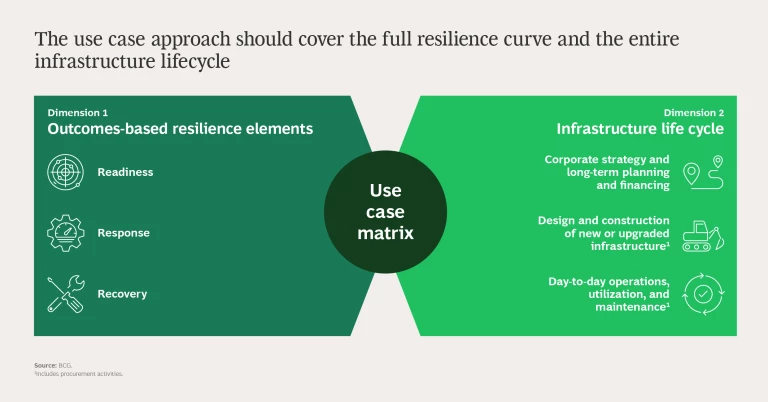
- The strategy-setting and long-term planning phases, including financing and governance, establish the organization’s foundational direction and resource allocation. Here, transportation organizations should use comprehensive risk assessments to help pinpoint vulnerabilities and ensure that their climate strategy is incorporated into high-level planning and capital investments.
- The design and construction phases for new or upgraded assets translate an organization’s strategic vision into tangible infrastructure. Given the long-term nature of these assets, it's imperative that organizations integrate climate resilience into them from design onward.
- Day-to-day operations and utilization, including monitoring and maintenance, are the phases in which impacts from acute climate events are felt the most. Tools such as real-time monitoring systems, especially in areas such as airports and marine ports, are essential to provide timely data on climate impacts and ensuring immediate intervention during adverse events.
Relevant Use Cases and Valuable Technologies
To build resilience along each element of the resilience curve and at each step of the infrastructure life cycle, advanced technologies such as AI, Earth observation, the Internet of Things (IoT) sensors, augmented reality (AR), and advanced computing can bring key capabilities to life. These include:
- Gathering, completing, and processing data
- Strengthening planning and decision making
- Optimizing processes in real time
- Powering discovery processes
- Nudging adaptive and risk-reducing behavior
AI, for instance, supports climate modeling and advanced weather forecasting by filling in data gaps and combining multiple sources to generate unprecedented detail. Climate impact can be experienced through immersive AR simulations. And Earth observation provides a macro view of planetary and large-scale geospatial data that complements micro data from distributed and connected IoT sensors, resulting in highly accurate early warning and disaster situation reporting.
Each of these technologies matches use cases that we have identified as enhancing infrastructure resilience and is supplemented by case studies that highlight the implementation process and impact. As organizations review these use cases, we encourage them to consider their own unique needs to determine which tech solutions will best apply, strengthening their overall resilience. (See the slideshow.)
As an example, an organization that needs to generate alerts about the likelihood and potential severity of floods could strategically place sensors in bodies of water, on land, and within infrastructure assets to monitor water levels, rainfall, and other weather conditions, integrating the resulting information into forecasted meteorological data, such as wind speed.
Another key use case is the employment of customizable software in support of emergency response teams, whether during their day-to-day operations or during a climate event. This capability can both improve communications and data-sharing and boost emergency preparedness and awareness, enhancing decision-making.
Refining and Prioritizing Chosen Use Cases
Once they have selected the leading use cases for their organization, leaders should refine and prioritize the list based on their most pressing needs, key gaps, and dependencies as well as the potential each use case offers for bolstering their resiliency. To help this process, they should conduct an internal capabilities assessment, speaking to key departments to understand where their strengths, weaknesses, and opportunities lie. For example, they could confer with their emergency management office for anything relevant to the “better response” section of the matrix in the exhibit. In addition, they could gather insights from their engineers and construction leaders about anything pertaining to “better readiness” in the design and construction phase, particularly about the materials to be used in upcoming projects.
Next, they should conduct a technology scan, including the following steps:
Benchmark peers. Organizations should try to understand the actions that other agencies in their field are taking to boost resilience, including unique initiatives, technology purchases, and external reports. Then, to highlight additional solutions, they should broaden this search to adjacent industries facing similar climate risks. For instance, microclimate forecasting models used in agriculture are finding applications in energy and transportation.
Identify startup solutions. Organizations should seek out emerging technologies—from seed-stage to mature startups—that may have applications in the transportation sector. Collaborations with such newcomers often provide opportunities for direct engagement with development teams, allowing for more tailored solutions, flexibility, and innovation compared to tech available from larger, established providers.
Expand existing solutions and capabilities. Departments often underutilize the capabilities of their own technology tools, missing out on features that could enhance resilience efforts. As part of their assessment, therefore, organizations should ensure that they are taking full advantage of their existing enterprise technology solutions. This additional research may reduce the need to integrate new tech with existing tools and might even eliminate the need to manage a new vendor. Leveraging existing technologies may also help to automate some internal processes, boosting efficiency and enhancing the time and quality of decision making.
Continue to monitor the tech landscape. Once they have established a comprehensive set of optimal technology solutions, transportation organizations should continue to observe the technology landscape, maintaining market intelligence by following trends and tracking capability gaps. This effort will allow them to periodically identify new solutions that address their priority use cases.
Envisioning a Resilient Future
Transportation organizations should be aware of a few key challenges inherent to the use case approach. Integrating new technologies into existing tech can be complex in terms of compatibility and scalability. In addition, new-technology development and evolution often follow nonlinear and unpredictable paths, adding a layer of complexity to the planning and implementation process. Finally—a challenge for any approach—the concept of building resilience is dynamic: priorities and goals shift as new information, technologies, and environmental conditions emerge and evolve.
To deal with these challenges most effectively, transportation agencies can:
- Eliminate silos in climate resilience efforts to avoid unnecessary redundancies, conflicts, and inefficient uses of technology output and data.
- Get buy-in from organizational, departmental, and political leaders. This can be crucial to ensuring the proper use and adoption of newly implemented tech.
- Take budgetary constraints into account when following this roadmap—adding technology only where it is most needed.
- Build the use case effort from the ground up, preparing each technology with a suite of supporting materials for success, such as the use cases it addresses, the business case, departmental and ownership buy-in, and best practices compiled from industry benchmarks. A methodical process such as this can reduce complexity and keep the organization from stretching internal capacity.
This comprehensive approach will help transportation organizations adapt to evolving technology and changing climate resilience requirements. It will also help them balance their immediate actions with their long-term strategic objectives, supporting resilience against both current and future climate challenges. Most important, it will establish a sustainable and consistent process that incorporates technology and data-driven decision making into the fabric of the organization's overarching climate resilience strategy.

